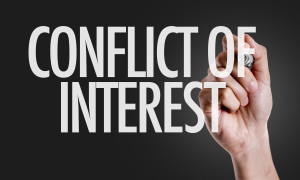 Out of necessity, a fiduciary’s performance of their duty will drive interactions with vendors of investment advice and administration services. Those interactions all have the potential to create real or perceived conflicts of interest with the trinity of ERISA fiduciary responsibility…independence, loyalty, and exclusive purpose.
Out of necessity, a fiduciary’s performance of their duty will drive interactions with vendors of investment advice and administration services. Those interactions all have the potential to create real or perceived conflicts of interest with the trinity of ERISA fiduciary responsibility…independence, loyalty, and exclusive purpose.
An often used definition is:
A conflict of interest is a set of circumstances that creates a risk that professional judgment or actions regarding a primary interest will be unduly influenced by a secondary interest.
In the employee benefits community, conflicts of interest emerge in one of three common ways:
- A person’s professional position provides them with a chance to use their influence to obtain personal financial gain or to advance the financial interests of the organization that employs them.
- Third party interests improperly influence the financial decisions of a person that has been granted discretion over other people’s assets held in trust such as a corporate retirement plan.
- A key employee’s imprudent participation in outside interests harms the reputation of the employer.
The U.S. Department of Labor does not require that ERISA plan fiduciaries manage conflict free retirement plans. In fact, conflicts of interest are not in and of themselves unethical or impermissible; indeed, they are often unavoidable and in many cases can be appropriately managed or reduced to an acceptable level.
The new Conflict of Interest Rule does, however, declare by its very existence that the current ERISA plan servicing industry has damaged worker’s retirement accounts through many vendors’ complex and conflicted business structures that mostly benefit those vendors.
Vendors’ conflicts of interest exist in every servicing category. The conflicts need to be exposed and carefully evaluated by ERISA plan fiduciaries in order to conclude if they are acceptable. Otherwise, workers’ retirement plan accounts will remain in harm’s way!




